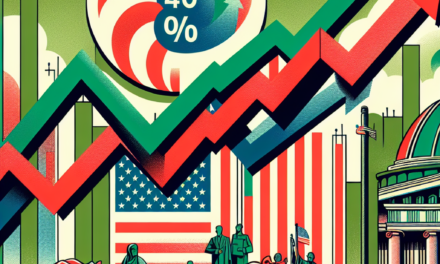“Market Momentum: Trump Triumphs, Fed Eases, Palantir Soars!”
Introduction
**Weekly Market Review: Stocks Surge on Trump Election, Fed Rate Cuts, and Palantir’s Rise**
In a week marked by significant political and economic developments, the stock market experienced a notable surge, driven by a confluence of factors that have captured the attention of investors worldwide. The election of Donald Trump as President of the United States has injected a fresh wave of optimism into the markets, with expectations of business-friendly policies and tax reforms fueling investor confidence. Concurrently, the Federal Reserve’s decision to implement rate cuts has provided additional stimulus, further buoying market sentiment. Amidst these macroeconomic shifts, Palantir Technologies has emerged as a standout performer, with its stock experiencing a remarkable rise, reflecting strong investor interest and confidence in its growth prospects. This review delves into the key events and trends that have shaped the market landscape over the past week, offering insights into the forces driving this upward momentum.
Impact Of Trump’s Election On Stock Market Surge
The recent surge in the stock market can be attributed to a confluence of significant events, each playing a pivotal role in shaping investor sentiment and market dynamics. Among these, the election of Donald Trump as President of the United States stands out as a major catalyst. Trump’s election brought with it a wave of optimism among investors, largely due to his pro-business stance and promises of tax cuts, deregulation, and infrastructure spending. These policy proposals were perceived as favorable to economic growth, prompting a bullish response from the stock market. The anticipation of a more business-friendly environment under Trump’s administration led to increased investor confidence, resulting in a notable uptick in stock prices.
In addition to the political landscape, monetary policy decisions have also played a crucial role in the recent market surge. The Federal Reserve’s decision to implement rate cuts has provided further impetus for the stock market’s upward trajectory. By lowering interest rates, the Fed aimed to stimulate economic activity by making borrowing cheaper for businesses and consumers. This move was particularly significant in the context of global economic uncertainties and trade tensions, as it provided a buffer against potential economic slowdowns. The rate cuts not only encouraged spending and investment but also made equities more attractive compared to fixed-income securities, thereby driving more capital into the stock market.
Moreover, the rise of Palantir Technologies has added another layer of interest and excitement to the market. As a leading player in the field of data analytics and software, Palantir’s strong performance and growth prospects have captured the attention of investors. The company’s innovative solutions and strategic partnerships have positioned it as a key player in the technology sector, further fueling investor enthusiasm. Palantir’s rise is emblematic of the broader trend of technology companies driving market gains, as they continue to innovate and adapt to the evolving needs of businesses and consumers.
The interplay between these factors—Trump’s election, Fed rate cuts, and Palantir’s rise—has created a dynamic environment that has propelled the stock market to new heights. However, it is important to recognize that while these elements have contributed to the current market surge, they also introduce a degree of uncertainty. Political developments, such as changes in policy direction or geopolitical tensions, can have unpredictable effects on market stability. Similarly, the long-term impact of monetary policy decisions remains a subject of debate among economists and market analysts.
As investors navigate this complex landscape, it is crucial to maintain a balanced perspective. While the current market conditions present opportunities for growth, they also require careful consideration of potential risks. Diversification and prudent risk management strategies are essential to safeguarding investments in an environment characterized by both optimism and uncertainty.
In conclusion, the recent surge in the stock market is a testament to the multifaceted nature of financial markets, where political, economic, and technological factors intersect to shape investor behavior. The election of Donald Trump, coupled with the Federal Reserve’s rate cuts and the rise of companies like Palantir, has created a unique set of circumstances that have driven market gains. As the market continues to evolve, staying informed and adaptable will be key to navigating the opportunities and challenges that lie ahead.
Analysis Of Fed Rate Cuts And Their Influence On Market Trends
In the wake of recent developments, the financial markets have experienced significant fluctuations, driven by a confluence of factors including the election of Donald Trump, the Federal Reserve’s strategic rate cuts, and the remarkable ascent of Palantir Technologies. These elements have collectively shaped investor sentiment and market dynamics, warranting a closer examination of their interplay and implications.
To begin with, the Federal Reserve’s decision to implement rate cuts has been a pivotal factor influencing market trends. Historically, rate cuts are employed as a monetary policy tool to stimulate economic activity by making borrowing cheaper, thereby encouraging spending and investment. In the current context, the Fed’s actions have been perceived as a proactive measure to counteract potential economic slowdowns and to bolster market confidence. Consequently, these rate cuts have injected liquidity into the financial system, providing a favorable environment for equities to thrive. Investors, buoyed by the prospect of lower borrowing costs, have shown increased appetite for riskier assets, propelling stock prices upward.
Simultaneously, the election of Donald Trump has introduced a new dimension to market dynamics. Trump’s economic policies, characterized by tax cuts and deregulation, have been met with optimism by many investors who anticipate a business-friendly environment conducive to corporate growth. This sentiment has been reflected in the stock market’s robust performance, as investors position themselves to capitalize on potential policy shifts. However, it is important to note that Trump’s election has also introduced elements of uncertainty, particularly in relation to trade policies and geopolitical tensions, which could pose risks to sustained market growth.
Amidst these broader economic developments, Palantir Technologies has emerged as a standout performer, capturing the attention of investors and analysts alike. The company’s innovative approach to data analytics and its expanding client base have fueled its rapid rise in the stock market. Palantir’s success underscores the growing importance of technology-driven solutions in today’s data-centric world. As businesses increasingly rely on data to drive decision-making, companies like Palantir are well-positioned to capitalize on this trend, further enhancing their market appeal.
The interplay between these factors—Fed rate cuts, Trump’s election, and Palantir’s rise—has created a complex landscape for investors to navigate. On one hand, the Fed’s accommodative monetary policy and Trump’s pro-business stance have provided a supportive backdrop for equities. On the other hand, the potential for policy missteps or geopolitical tensions remains a source of concern. Investors must therefore remain vigilant, balancing optimism with caution as they assess the evolving market environment.
In conclusion, the recent surge in stock markets can be attributed to a combination of strategic rate cuts by the Federal Reserve, the election of Donald Trump, and the impressive performance of companies like Palantir Technologies. While these factors have collectively bolstered market sentiment, they also underscore the inherent complexities and uncertainties that characterize today’s financial landscape. As investors continue to navigate these dynamics, a nuanced understanding of the interplay between monetary policy, political developments, and technological innovation will be essential in making informed investment decisions.
Palantir’s Rise: A Deep Dive Into Its Market Performance
In the ever-evolving landscape of technology and data analytics, Palantir Technologies has emerged as a formidable player, capturing the attention of investors and analysts alike. This week, Palantir’s market performance has been particularly noteworthy, driven by a confluence of factors that have propelled its stock to new heights. As we delve into the intricacies of Palantir’s rise, it is essential to consider the broader market context, including the recent U.S. presidential election, Federal Reserve rate cuts, and the company’s strategic maneuvers.
Palantir, a company renowned for its sophisticated data analytics platforms, has seen its stock surge significantly. This upward trajectory can be attributed to several key developments. Firstly, the election of Donald Trump has introduced a wave of optimism in certain sectors, particularly those aligned with defense and national security, areas where Palantir has established a strong foothold. The company’s government contracts, which form a substantial portion of its revenue, are expected to flourish under an administration that prioritizes defense spending and data-driven decision-making.
Moreover, the Federal Reserve’s decision to implement rate cuts has injected liquidity into the market, encouraging investment in growth-oriented technology stocks. Palantir, with its innovative solutions and expanding client base, stands to benefit from this influx of capital. Investors, seeking to capitalize on the low-interest environment, are increasingly drawn to companies like Palantir that promise robust growth potential and a competitive edge in the burgeoning field of big data analytics.
In addition to these external factors, Palantir’s internal strategies have played a pivotal role in its market ascent. The company has been proactive in diversifying its client portfolio, extending its reach beyond government contracts to include a wide array of commercial enterprises. This strategic expansion has not only bolstered its revenue streams but also enhanced its resilience against potential fluctuations in government spending. By forging partnerships with leading corporations across various industries, Palantir has demonstrated its versatility and adaptability, key attributes that resonate well with investors.
Furthermore, Palantir’s commitment to innovation and technological advancement has been instrumental in its rise. The company continues to invest heavily in research and development, ensuring that its platforms remain at the cutting edge of data analytics. This dedication to innovation is reflected in its ability to deliver tailored solutions that address the unique challenges faced by its clients, thereby solidifying its reputation as a leader in the field.
As we consider Palantir’s market performance, it is also important to acknowledge the challenges that lie ahead. The competitive landscape of data analytics is intensifying, with numerous players vying for market share. Palantir must navigate this environment with strategic acumen, leveraging its strengths while remaining vigilant to emerging trends and potential disruptions.
In conclusion, Palantir’s rise in the market is a testament to its strategic foresight, innovative prowess, and ability to capitalize on favorable external conditions. The interplay of political developments, economic policies, and the company’s own initiatives has created a fertile ground for its growth. As Palantir continues to chart its course in the dynamic world of data analytics, its performance will undoubtedly be closely watched by investors and industry observers, eager to glean insights into the future trajectory of this remarkable company.
Comparing Market Reactions: Trump Election Vs. Fed Rate Cuts
In the ever-evolving landscape of financial markets, understanding the nuances of market reactions to significant events is crucial for investors and analysts alike. This week, the spotlight is on the remarkable surge in stock markets, driven by a confluence of factors including the election of Donald Trump, recent Federal Reserve rate cuts, and the impressive rise of Palantir Technologies. By comparing the market reactions to Trump’s election and the Fed’s monetary policy adjustments, we can gain valuable insights into the dynamics that influence investor sentiment and market performance.
The election of Donald Trump in 2016 marked a pivotal moment in U.S. political history, with profound implications for financial markets. Initially, the unexpected victory sent shockwaves through global markets, leading to a brief period of volatility. However, as investors began to digest the potential economic policies of the Trump administration, optimism took hold. The promise of tax cuts, deregulation, and infrastructure spending fueled a rally in equities, particularly in sectors such as financials and industrials. This post-election surge, often referred to as the “Trump bump,” underscored the market’s sensitivity to policy shifts and the anticipation of pro-business reforms.
In contrast, the Federal Reserve’s recent decision to cut interest rates has had a more nuanced impact on the markets. Rate cuts are typically employed as a tool to stimulate economic growth by making borrowing cheaper and encouraging investment. The Fed’s actions, aimed at countering economic slowdowns and mitigating risks, have provided a supportive backdrop for equities. However, the market’s response to rate cuts is often contingent on the broader economic context. In this instance, while the rate cuts have bolstered investor confidence, they also reflect underlying concerns about economic stability, which can temper the enthusiasm seen in the aftermath of Trump’s election.
Transitioning to the present, the rise of Palantir Technologies has added another layer of complexity to the market narrative. As a data analytics company with a focus on government and commercial applications, Palantir’s ascent has captured the attention of investors seeking exposure to innovative technology firms. The company’s strong performance in the stock market is indicative of a broader trend where investors are increasingly drawn to tech-driven growth stories. This enthusiasm for technology stocks, often seen as a barometer of future economic potential, contrasts with the more traditional sectors that benefited from Trump’s election promises.
While both Trump’s election and the Fed’s rate cuts have catalyzed market movements, they do so through different mechanisms. The former relies heavily on policy expectations and the potential for structural economic changes, while the latter is rooted in monetary policy adjustments aimed at stabilizing economic conditions. The interplay between these factors highlights the complexity of market dynamics, where investor sentiment is shaped by a myriad of influences ranging from political developments to central bank actions.
In conclusion, the recent surge in stock markets serves as a testament to the multifaceted nature of market reactions. By examining the distinct yet interconnected impacts of Trump’s election, Fed rate cuts, and Palantir’s rise, we gain a deeper understanding of how various forces converge to shape market trajectories. As investors navigate this intricate landscape, staying attuned to both macroeconomic indicators and sector-specific trends will be essential in making informed decisions. Ultimately, the ability to discern the underlying drivers of market movements remains a key skill for those seeking to capitalize on opportunities in an ever-changing financial environment.
Key Factors Driving The Stock Market Surge Post-Election
In the wake of the recent U.S. presidential election, the stock market has experienced a significant surge, driven by a confluence of factors that have bolstered investor confidence and fueled optimism about the economic outlook. Central to this market rally is the election of Donald Trump, whose victory has been perceived by many investors as a catalyst for potential economic growth. Trump’s pro-business stance, coupled with his promises of tax cuts and deregulation, has invigorated market participants who anticipate a more favorable business environment. This optimism has been reflected in the stock market’s upward trajectory, as investors position themselves to capitalize on potential policy shifts that could stimulate economic activity.
In addition to the political landscape, the Federal Reserve’s recent decision to cut interest rates has played a pivotal role in the stock market’s ascent. By lowering borrowing costs, the Fed aims to support economic growth and stave off potential downturns. This monetary policy adjustment has provided a boost to equities, as lower interest rates typically enhance the attractiveness of stocks relative to bonds. Furthermore, the rate cuts have alleviated some concerns about the global economic slowdown, encouraging investors to reallocate capital into riskier assets such as equities. The Fed’s actions have thus reinforced the market’s upward momentum, creating a more conducive environment for stock appreciation.
Another significant factor contributing to the stock market’s rise is the impressive performance of Palantir Technologies, a data analytics company that has captured the attention of investors. Since its public debut, Palantir has demonstrated robust growth, driven by its innovative approach to data management and analysis. The company’s ability to secure high-profile contracts with government agencies and private enterprises has underscored its potential for sustained revenue growth. As a result, Palantir’s stock has surged, reflecting investor confidence in its long-term prospects. This surge has not only benefited Palantir’s shareholders but has also contributed to the broader market rally, as the company’s success has been emblematic of the potential for technology-driven growth in the current economic climate.
Moreover, the interplay between these factors has created a synergistic effect that has amplified the stock market’s gains. The anticipation of pro-growth policies under the Trump administration, combined with the Fed’s accommodative monetary stance, has fostered a sense of optimism that has permeated the market. This optimism has been further bolstered by the strong performance of companies like Palantir, which exemplify the potential for innovation and growth in the technology sector. Consequently, investors have been emboldened to increase their exposure to equities, driving stock prices higher and reinforcing the market’s upward trajectory.
In conclusion, the recent surge in the stock market can be attributed to a combination of political, monetary, and corporate factors that have collectively enhanced investor sentiment. The election of Donald Trump, the Federal Reserve’s rate cuts, and the rise of Palantir Technologies have each played a crucial role in shaping the current market landscape. As these dynamics continue to unfold, investors will be closely monitoring developments to assess their potential impact on the market’s future direction. The interplay of these factors underscores the complexity of the financial markets and highlights the importance of understanding the broader economic context in which they operate.
The Role Of Technology Stocks In The Recent Market Rally
In the recent market rally, technology stocks have played a pivotal role, driving significant gains and capturing the attention of investors worldwide. The surge in stock prices following the election of Donald Trump, coupled with the Federal Reserve’s decision to cut interest rates, has created a fertile environment for tech companies to thrive. Among these, Palantir Technologies has emerged as a standout performer, reflecting broader trends within the sector.
To begin with, the election of Donald Trump has had a profound impact on market sentiment, particularly benefiting technology stocks. Trump’s pro-business stance and promises of deregulation have instilled confidence among investors, leading to increased capital inflows into the tech sector. This optimism is further bolstered by the administration’s focus on innovation and infrastructure, which are expected to create new opportunities for technology companies. As a result, tech stocks have experienced a notable upswing, contributing significantly to the overall market rally.
In addition to political factors, the Federal Reserve’s decision to cut interest rates has provided a substantial boost to technology stocks. Lower interest rates reduce the cost of borrowing, enabling tech companies to invest more in research and development, expand their operations, and pursue strategic acquisitions. This environment of cheap capital has allowed technology firms to innovate and grow at an accelerated pace, further enhancing their appeal to investors. Consequently, the tech sector has become a key driver of the recent market rally, with many companies posting impressive gains.
Among the technology stocks that have captured the spotlight, Palantir Technologies stands out as a notable example. The company’s rise can be attributed to its unique position in the market, offering data analytics solutions that are increasingly in demand across various industries. Palantir’s ability to provide actionable insights from vast amounts of data has made it an indispensable tool for businesses and governments alike. This growing reliance on data-driven decision-making has propelled Palantir’s stock to new heights, reflecting the broader trend of technology stocks leading the market rally.
Moreover, the rise of Palantir highlights the increasing importance of data and analytics in today’s economy. As businesses seek to gain a competitive edge, the demand for sophisticated data analysis tools continues to grow. This trend is not limited to Palantir alone; other tech companies specializing in artificial intelligence, machine learning, and cloud computing are also experiencing significant growth. These technologies are reshaping industries and driving efficiency, further solidifying the role of technology stocks in the market rally.
Furthermore, the success of technology stocks in the recent market rally underscores the sector’s resilience and adaptability. Despite global economic uncertainties and geopolitical tensions, tech companies have demonstrated their ability to navigate challenges and capitalize on emerging opportunities. This resilience is a testament to the sector’s innovative spirit and its capacity to drive economic growth.
In conclusion, technology stocks have been instrumental in the recent market rally, fueled by favorable political and economic conditions. The election of Donald Trump and the Federal Reserve’s rate cuts have created an environment conducive to growth, allowing tech companies to flourish. Palantir Technologies exemplifies the sector’s potential, with its rise reflecting the increasing importance of data analytics. As technology continues to evolve and reshape industries, its role in driving market gains is likely to persist, making it a focal point for investors seeking growth opportunities.
Investor Sentiment: How Political Events Shape Market Movements
Investor sentiment is a crucial factor in shaping market movements, often swaying the direction of stocks in response to political events. This week, the markets experienced a notable surge, driven by a confluence of political and economic developments. The election of Donald Trump, the Federal Reserve’s decision to cut interest rates, and the remarkable rise of Palantir Technologies have collectively influenced investor behavior, underscoring the intricate relationship between politics and market dynamics.
To begin with, the election of Donald Trump has historically been associated with significant market reactions. His policies, particularly those related to tax cuts and deregulation, have often been perceived as business-friendly, fostering a sense of optimism among investors. This optimism was evident in the immediate aftermath of his election, as markets rallied in anticipation of economic growth and increased corporate profitability. Investors, buoyed by the prospect of a favorable business environment, have shown a propensity to embrace risk, leading to a surge in stock prices.
In addition to political developments, monetary policy decisions by the Federal Reserve play a pivotal role in shaping investor sentiment. This week, the Fed’s decision to cut interest rates further fueled market enthusiasm. Lower interest rates typically reduce the cost of borrowing, encouraging businesses to invest and expand. Moreover, they make equities more attractive relative to fixed-income securities, prompting investors to shift their portfolios towards stocks. The rate cut, therefore, acted as a catalyst, amplifying the positive sentiment already generated by the political landscape.
Simultaneously, the rise of Palantir Technologies has captured the attention of investors, adding another layer of complexity to the market’s upward trajectory. As a company specializing in data analytics and software solutions, Palantir’s growth prospects have been bolstered by increasing demand for data-driven decision-making across various industries. The company’s strong performance and strategic partnerships have instilled confidence among investors, contributing to the broader market rally. Palantir’s ascent serves as a testament to the market’s responsiveness to innovative companies that are well-positioned to capitalize on emerging trends.
While these factors have collectively driven the market surge, it is essential to recognize the underlying dynamics of investor sentiment. Political events, such as elections, often serve as a barometer for future policy directions, influencing investor expectations and risk appetite. Similarly, monetary policy decisions by central banks can either bolster or dampen market confidence, depending on their alignment with investor expectations. In this context, the interplay between political developments and monetary policy becomes evident, as both elements converge to shape market movements.
Furthermore, the rise of individual companies like Palantir highlights the importance of sector-specific developments in influencing investor sentiment. As investors seek opportunities in high-growth sectors, the performance of key players within these industries can significantly impact market trends. This underscores the need for investors to remain vigilant and adaptable, as market dynamics are continually shaped by a myriad of factors.
In conclusion, the recent surge in stock markets can be attributed to a combination of political events, monetary policy decisions, and sector-specific developments. The election of Donald Trump, the Federal Reserve’s rate cuts, and Palantir’s rise have collectively influenced investor sentiment, driving market movements. As investors navigate this complex landscape, understanding the interplay between these factors is crucial for making informed investment decisions. Ultimately, the dynamic relationship between politics and markets underscores the importance of staying attuned to both macroeconomic trends and individual company performances.
Q&A
1. **What was the overall market trend during the week?**
Stocks surged significantly.
2. **What major political event influenced the market?**
The election of Donald Trump.
3. **How did the Federal Reserve impact the market?**
The Fed implemented rate cuts.
4. **Which company’s stock saw a notable rise?**
Palantir’s stock experienced a significant increase.
5. **What sectors benefited the most from the market surge?**
Financials and industrials were among the sectors that benefited.
6. **How did investors react to Trump’s election in terms of market behavior?**
Investors were optimistic, leading to increased buying activity.
7. **What was a key factor in Palantir’s stock rise?**
Strong earnings reports and positive future outlooks contributed to the rise.
Conclusion
The weekly market review highlights a significant surge in stock markets driven by three key factors: the election of Donald Trump, anticipated Federal Reserve rate cuts, and the impressive rise of Palantir Technologies. Trump’s election has injected optimism into the markets, with expectations of business-friendly policies and economic growth. Concurrently, the prospect of Fed rate cuts has bolstered investor confidence, suggesting a more accommodative monetary policy environment. Additionally, Palantir’s strong performance has captured investor interest, contributing to the overall market rally. Together, these elements have created a favorable environment for stocks, reflecting positive investor sentiment and potential economic expansion.





